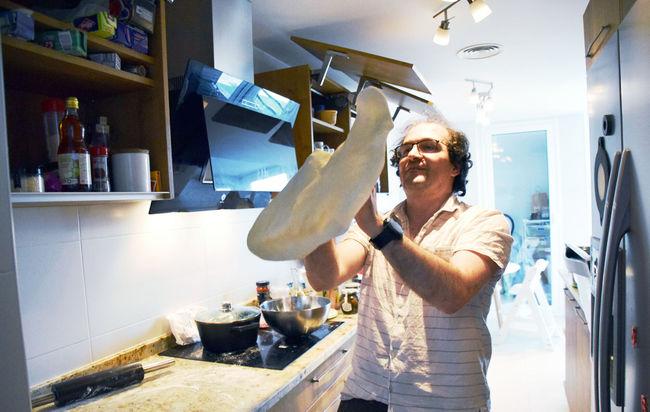Contents |
Pizza
Just a statue? Is the Statue of Liberty just a statue? Is the Leaning Tower of Pizza just a statue?
Homer Simpson.
The pizza is the pinnacle of Italian cuisine, an instant hit with everybody and all cultures since it combines the best of everything that is fundamental: bread (the dough is basically the same, except it comes with olive oil) in an optimized form to eat (flat, thin and round) topped with tomato-sauce and, the final key to its success, a great variety of toppings, from quattro formaggi to a variety of meat (diavola, pepperoni, salami, ham, German sausages, etc.) passing by vegetables, mushrooms, fine cheese (mozzarella), tuna, and even such exotic things as artichokes, pineapples or chocolate. As is the case with all fast-food, it also comes in its absurdly expensive version (e.g., with truffle, ossetra caviar, foie-gras and.... gold! [1])
The first recorded mentions come from the city of Gaeta while still part of the Byzantine Empire, in 997AD, mentioning that a tenant of certain property is to give the bishop duodecim pizze, and the modern version is attributed to the neighboring Naples, which remains the focal point for the purest version. Various locations are associated to various toppings, but maybe more critically, the type of crust distinguishes the various types, with the Roman version pizza romana presenting the slimmer and crunchier style of pizza; in our opinion, the best. The Neapolitan, in comparison, in line with its origin as daily food, is thicker and more bread-like.
Most famous versions are:
- Pizza Napolitana, the historical, iconic version (with a society to protect its preparation, including a selection of tomatoes).
- Pizza Margherita, one of the simplest (and lowest-cost in restaurants), with the colors of Italy (green basil, white mozzarella and red tomatoes).
- Pizza ai quattro formaggi, four-cheese, a favourite (see below).
- Pizza quattro stagioni, in four sections with ingredient representing one season of the year (Artichokes for spring, tomatoes/basil for summer, mushrooms for autumn and ham, prosciutto or olives for winter).
- Pizza capricciosa with a bit of everything (ham, mozzarella, mushrooms, olives, even sometimes eggs, etc.)
- Pizza Pugliese, with onions, and from one great and underrated part of the country.
Also of notice is the Chicago-style pizza (dip-dish), which we tried when visiting Chicago, or the Sicilian pizza (sfincione).
Quattro Formaggi
The four-cheese is one of our favorites, both to order, in restaurants or home-made. Although it is one of the most popular and famous worldwide, it didn't get its own wikipedia entry until Fabrice created it (on 25 April (2020)). It is also notoriously ignored from specialized books, such as the so-called pizza bible[1], where it is mentioned only once (but there's a lot of discussion of the quattro forni concept of using four ovens), or from this historical account[2] where it does not appear at all), so it is unclear where it comes from (one restaurant dates it early 18th century from around Rome).
It needs mozzarella but, not being in Italy most of the time, we typically replace the three other partners by other types of cheese, such as Cheddar (great with anchovy), Manchego, Camembert and Bleu (d'Auvergne, des Causses, Roquefort, etc.)
Recipe
Dough / Pâte à pizza

- 500g de farine
- 20g de levure de boulanger fraîche ou 10g de levure sèche
- 3 (ou plus, jusqu'à 5) cuillerées à soupe d'huile d'olive
- 250 ml d'eau tiède
- 1 petite cuillère de sel
- 1 petite cuillère de sucre (facultatif)
Utiliser le crochet pétrisseur du mélangeur et mettre 50ml de l'eau dans la cuve avec la levure (et le sucre). Attendre entre 5 et 10 minutes.
Ajouter la farine, 2 cuillerées à soupe d'huile d'olive et pétrir à la vitesse 1 en ajoutant l'eau.
Ajouter le sel en cours de pétrissage.
Rectifier au besoin la quantité d'eau pour obtenir une pâte souple mais pas trop molle. Une fois la pâte en boule, la couvrir d'un torchon et laisser lever à température ambiante/ tiède pendant au moins une heure.
Mettre la pâte sur une planche farinée et la pétrir à la main quelques instants pour chasser le gaz.
Diviser la pâte en 2 ou 3 pâtons (congeler une partie au besoin pour usage ultérieur).
Etaler chaque pâton sur une plaque. Laisser reposer une demi-heure avant de garnir.
Appareil
- 1kg de tomates (mûres)
- 3 gousses d'ail
- 1 oignon
- 3 branches de thym
- 2 feuilles de laurier
- 1 cuillèrée à soupe d'oregano
- 3 cuillères à soupe d'huile d'olive
- 1 cuillère à café de concentré de tomates
Faire revenir l'ail dans l'huile. Broyer les tomates pelées (on peut les jeter dans l'eau bouillante après incision en forme de croix à leur tête pour faciliter cette tâche) grossièrement et les ajouter à la casserole avec le reste des ingrédients. Laisser mijoter doucement environ un quart d'heure minutes, sans couvrir. Répartir sur la pâte à pizza et garnir.
Garniture
- Quatre fromages: il faut de la mozarrella. Les autres fromages devraient inclure un bleu, un crémeux/doux/mou (gouda, emental, gruyère, cheddar, camembert) et un fromage plus dur (parmesan, ). Rien n'empêche d'en mettre plus, par sections (cinq-fromages, six-fromages, etc., sans arriver aux 101 fromages du record actuel).
- Salami: salami, petites tomates, fromage rapé, oignons.
- Champignons: de Paris, blancs, avec des oignons et du fromage rapé.
- Saucisses Allemandes: Bratwurst, oignons, fromage rapé.
- Espagnole: poivrons, chorizo, olives, fromage rapé.
References
- ↑ The Pizza Bible: The World's Favorite Pizza Styles, from Neapolitan, Deep-Dish, Wood-Fired, Sicilian, Calzones and Focaccia to New York, New Haven, Detroit, and More, Ten Speed Press, Tony Gemignani, 2014.
- ↑ Pizza: A Global History, Carol F. Helstosky, Reaktion Books, 2008.
| |||||||||||||||||